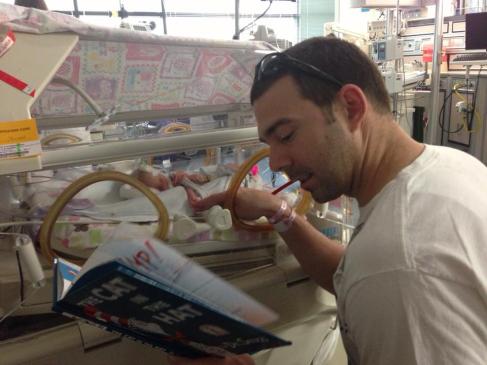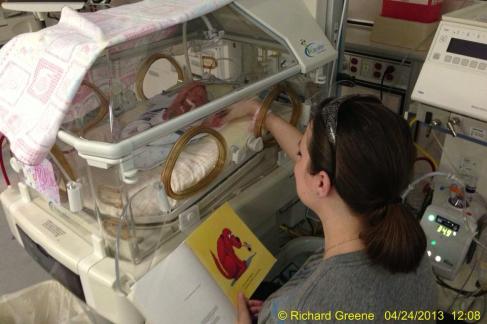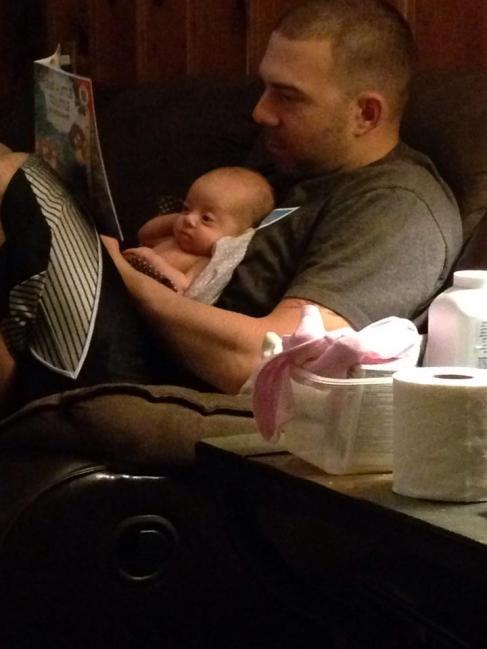It’s another glorious July morning and let me tell you the weather couldn’t be any better either could the babies.
So this morning I decided to write about babies and their brains, or minds. Reason I decided to bring this up because Heather and I over the last 3 months have always been questioned on why we read or sing to our girls? People always want to wonder why we bother, they are to young to understand… I usually give them a dumbfounded look if we are in person and if I read the comment online I usually use some explecit words to describe the person and their intellectual well being.
So to answer everyone’s question on why we do it, both of us have always been lovers of literature and this is something that we wish to empart on our children as well. Not only this but it is proven that reading and singing to babies even inside the womb will begin engaging their minds, I have taken the liberty to add some content from two seperate sites as well as the links.
——————————————————————————————————-
Scholastic
Babies don’t so much read books as explore them. It’s not about the words, the story, or the sound of your voice. It’s not about the pictures. It’s not about the physical book itself. It’s actually about all of the above, combined. Babies use all their senses to take in a book. Your job is to keep your mind open to the possibilities — a book can be just as satisfying as reading it — and have fun. It can take a lot of patience to get through even a short picture book with a baby, but you’ll be rewarded with a child who’s received an excellent start to literacy — and life. Here are some dos and don’ts for you and your budding reader:
Do
Expand your child’s “library.” Very little babies have no real idea what you’re reading, so why not read aloud to her from whatever you’re reading, like a novel or a magazine? That way you both get to hear terrific stories together.
Expose her to art. Show your baby pictures from the family photo album or a coffee table art book — just be careful she doesn’t grab precious pages! Babies enjoy looking at images and respond well to simple, high-contrast pictures.
Get tactile. Touch-and-feel books, like the classic Pat the Bunny, are great sensory as well as literary tools. Guide your baby’s hand over various textures while you read.
Follow your baby’s lead. Some babies like to open and close books, hand them back to you, or stack them like blocks. That counts as “reading” too. The more you use books for fun, the more likely she’ll see that they are an enjoyable part of her daily life.
Keep books handy. Stow board books in your stroller, diaper bag, car, near the highchair, at the changing table, or even in the bathtub (there are some wonderful waterproof bath books). You’ll always have a book ready to distract and entertain.
Read enthusiastically. Use silly voices, make animal sounds, and read with drama.
Hand your baby a book. When your baby’s reached the “grabbing” stage, he’s likely to take the book out of your hands. Let him; just have a couple books on hand so you can switch back and forth and read them all at once.
Be prepared to repeat, and repeat, and repeat. Babies often get stuck on a particular favorite, and will zoom right to that book on the shelf even if you offer others. Repetition and familiarity are soothing to babies and toddlers. Let her have her way — she’ll pick a new favorite soon enough.
Point to pictures. For your pre-literate baby, illustrations are just as important (sometimes more so) than words. Don’t feel you have to read every page every time, but do point at the pictures (“Look at the green car!” “Where’s the moon?”) as you flip pages.
Join the public library. It’s a great way to expand your reading repertoire. You can join story-time groups and classes and meet other families.
Don’t
Take it personally when baby rejects reading. Your infant may have seemed relaxed and ready to settle in to “read” with you, but after one page he starts squalling. Just put the book aside; he’ll have a better moment again soon.
Stop your baby from mouthing books. This is one of the ways your baby explores books; it’s part of how she learns about everything in her world.
Be surprised when your toddler crawls away. Two things to remember about a toddler: he is more interested in moving than sitting still, and he can still hear you. Keep reading — he’ll come back (and if not, you can try again later).
Get mad at ripped pages. Has she ripped off a dinosaur’s head? Don’t get upset with her. Babies are stronger than most books! Plenty of baby-friendly board books are made just for the purpose of being gnawed and chewed. Just refrain from giving children under 2 pop-up books and from reading “good” books that you’d like to save for when she’s older. Toddlers may be interested in helping you fix torn books. Keep some tape handy for repairs.
Think you have to finish every book you start. For your baby or toddler, the process is more important than the outcome. You may not have reached the end of the book, but you did share some nice reading time together.
Give away baby books prematurely. Even when he grows into the next stage, he may like to revisit her old, gummed, and torn favorites.
Read at the same pace all the time. Speed up or slow down, depending on your baby’s interest.
Underestimate your baby. You may not be able to see it right away, but your baby is profiting sensually, intellectually, and socially thanks to your reading.
——————————————————————————————————-
Kid’s Health.org
Why Read to My Baby?
You may wonder about the benefits of reading to your baby. An infant won’t understand everything you’re doing or why. But you wouldn’t wait until your child could understand what you were saying before you started speaking to him or her, right? Nor would you bypass lullabies until your baby could carry a tune or wait until he or she could shake a rattle before you offered any toys.
Reading aloud to your baby is a wonderful shared activity you can continue for years to come — and it’s an important form of stimulation.
Reading aloud:
teaches a baby about communication
introduces concepts such as numbers, letters, colors, and shapes in a fun way
builds listening, memory, and vocabulary skills
gives babies information about the world around them
Believe it or not, by the time babies reach their first birthday they will have learned all the sounds needed to speak their native language. The more stories you read aloud, the more words your child will be exposed to and the better he or she will be able to talk.
Hearing words helps to build a rich network of words in a baby’s brain. Kids whose parents frequently talk/read to them know more words by age 2 than children who have not been read to. And kids who are read to during their early years are more likely to learn to read at the right time.
When you read, your child hears you using many different emotions and expressive sounds, which fosters social and emotional development. Reading also invites your baby to look, point, touch, and answer questions — all of which promote social development and thinking skills. And your baby improves language skills by imitating sounds, recognizing pictures, and learning words.
But perhaps the most important reason to read aloud is that it makes a connection between the things your baby loves the most — your voice and closeness to you — and books. Spending time reading to your baby shows that reading is a skill worth learning. And, if infants and children are read to often with joy, excitement, and closeness, they begin to associate books with happiness — and budding readers are created.
Different Ages, Different Stages
Young babies may not know what the pictures in a book mean, but they can focus on them, especially faces, bright colors, and contrasting patterns. When you read or sing lullabies and nursery rhymes, you can entertain and soothe your infant.
Between 4 and 6 months, your baby may begin to show more interest in books. He or she will grab and hold books, but will mouth, chew, and drop them as well. Choose sturdy vinyl or cloth books with bright colors and repetitive or rhyming text.
Between 6 and 12 months, your child is beginning to understand that pictures represent objects, and most likely will develop preferences for certain pictures, pages, or even entire stories. Your baby will respond while you read, grabbing for the book and making sounds, and by 12 months will turn pages (with some help from you), pat or start to point to objects on a page, and repeat your sounds.
When and How to Read
Here’s a great thing about reading aloud: It doesn’t take special skills or equipment, just you, your baby, and some books. Read aloud for a few minutes at a time, but do it often. Don’t worry about finishing entire books — focus on pages that you and your baby enjoy.
Try to set aside time to read every day — perhaps before naptime and bedtime. In addition to the pleasure that cuddling your baby before bed gives both of you, you’ll also be making life easier by establishing a routine. This will help to calm your baby and set expectations about when it’s time to sleep.
It’s also good to read at other points in the day. Choose times when your baby is dry, fed, and alert. Books also come in handy when you’re stuck waiting, so have some in the diaper bag to fill time sitting at the doctor’s office or standing in line at the grocery store.
Here are some additional reading tips:
Cuddling while you read helps your baby feel safe, warm, and connected to you.
Read with expression, pitching your voice higher or lower where it’s appropriate or using different voices for different characters.
Don’t worry about following the text exactly. Stop once in a while and ask questions or make comments on the pictures or text. (“Where’s the kitty? There he is! What a cute black kitty.”) Your child might not be able to respond yet, but this lays the groundwork for doing so later on.
Sing nursery rhymes, make funny animal sounds, or bounce your baby on your knee — anything that shows that reading is fun.
Babies love — and learn from — repetition, so don’t be afraid of reading the same books over and over. When you do so, repeat the same emphasis each time as you would with a familiar song.
As your baby gets older, encourage him or her to touch the book or hold sturdier vinyl, cloth, or board books. You don’t want to encourage chewing on books, but by putting them in his or her mouth, your baby is learning about them, finding out how books feel and taste — and discovering that they’re not edible!
What to Read
Books for babies should have simple, repetitive text and clear pictures. During the first few months of life, your child just likes to hear your voice, so you can read almost anything, especially books with a sing-song or rhyming text. As your baby gets more interested in looking at things, choose books with simple pictures against solid backgrounds.
Once your baby begins to grab, you can read vinyl or cloth books that have faces, bright colors, and shapes. When your baby begins to respond to what’s inside of books, add board books with pictures of babies or familiar objects like toys. When your child begins to do things like sit up in the bathtub or eat finger foods, find simple stories about daily routines like bedtime or bathtime. When your child starts talking, choose books that invite babies to repeat simple words or phrases.
Books with mirrors and different textures (crinkly, soft, scratchy) are also great for this age group, as are fold-out books that can be propped up, or books with flaps that open for a surprise. Board books make page turning easier for infants and vinyl or cloth books can go everywhere — even the tub. Babies of any age like photo albums with pictures of people they know and love. And every baby should have a collection of nursery rhymes!
One of the best ways you can ensure that your little one grows up to be a reader is to have books around your house. When your baby is old enough to crawl over to a basket of toys and pick one out, make sure some books are included in the mix.
In addition to the books you own, take advantage of those you can borrow from the library. Many libraries have storytime just for babies, too. Don’t forget to pick up a book for yourself while you’re there. Reading for pleasure is another way you can be your baby’s reading role model.
——————————————————————————————————-
So there you have it and I believe that most people will now understand why we read to our babies, and why we will continue to read to them until they can start reading back to us. I wanted to finish my little post with a few pictures of us and their girls. Also if you can please like, share, and follow my blog.
Daddy reading to Bristol
————————————————————————————————————————-
Mommy reading to Aurora
————————————————————————————————————————-
Daddy reading to Aurora
————————————————————————————————————————-



